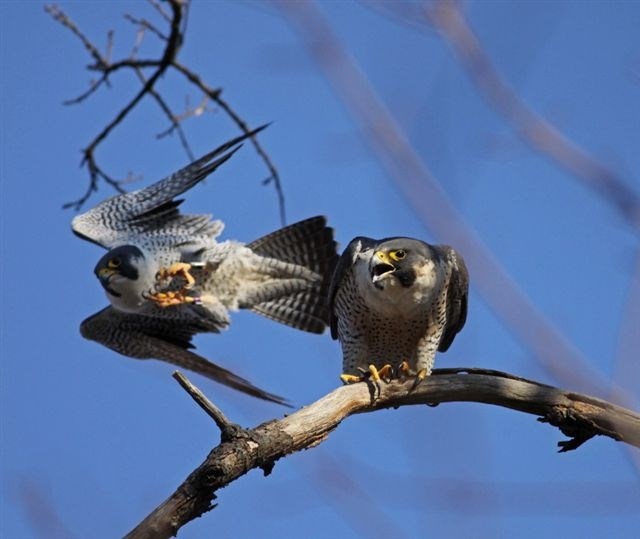Monogamy in the animal kingdom is defined as pair bonding between a male and female, which exclusively mate with one another, raise offspring together and spend time together. Monogamous relationships in the wild may be for life, but it also may be just for a season. Let's take a look at a few of the monogamous species you may see during your next visit.
 NPS Photo/Warren Tam - Red-Tailed Hawk (Buteo jamaicensis) carefully descends into nest
NPS Photo/Warren Tam - Red-Tailed Hawk (Buteo jamaicensis) carefully descends into nest Red-Tailed Hawks (Buteo jamaicensis):
Red-Tailed Hawks reach maturation at three years of age and will soon after choose their mate. These species have been known to mate with the same individual for many years, typically changing only if the original mate dies. Their courtship, like many raptors, tend to include soaring flights. Red-Tailed Hawks will soar together in circles for several minutes before landing on a perch. Together they will first preen each other and then copulation may take place.
 NPS Photo/Warren Tam - Osprey (Pandion haliaetus) clasps a fish in his talons
NPS Photo/Warren Tam - Osprey (Pandion haliaetus) clasps a fish in his talons Osprey (Pandion haliaetus):
These ocean predators are known to perform an aerial "dance" during breeding season. Often clasping a fish or nesting materials in his talons, the male flies above the nest site alternating between slow hovering and shallow swoops while uttering a repeated call. This display may occur for 10 minutes or more as he descends to the nest to meet his pair. Although these birds reach sexual maturity around the age of three, they may not start to breed until five to seven years old.
 NPS/Cuyahoga Valley - Peregrine Falcon pair, called "Rocky" and "Lara", that resides in Cuyahoga Valley, https://www.nps.gov/cuva/peregrine-falcons.htm
NPS/Cuyahoga Valley - Peregrine Falcon pair, called "Rocky" and "Lara", that resides in Cuyahoga Valley, https://www.nps.gov/cuva/peregrine-falcons.htmPeregrine Falcons (Falco peregrinus):
Peregrine Falcons form a strong attachment to their previous nesting sites. This attachment to the nesting site allows them to find the same mate spanning multiple breeding seasons, thus explaining their monogamous mating habits. Bonding pairs before mating may engage in incredible aerial displays, including power dives, tight cornering, high soaring and body rolls as they dive. Once the pair has bonded, they tend to hunt cooperatively and females may begin to request for food from the male.
